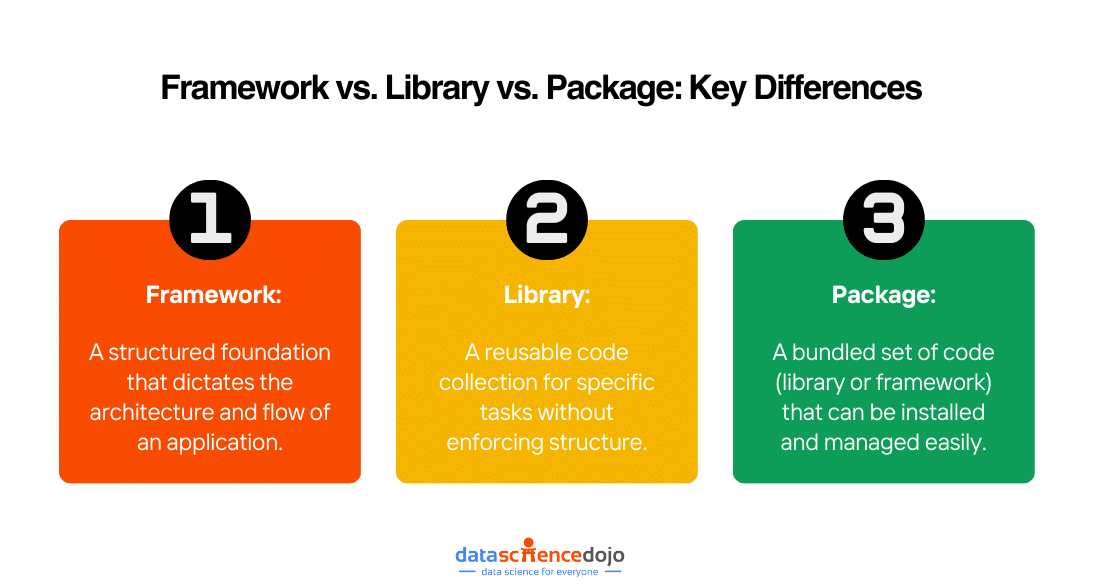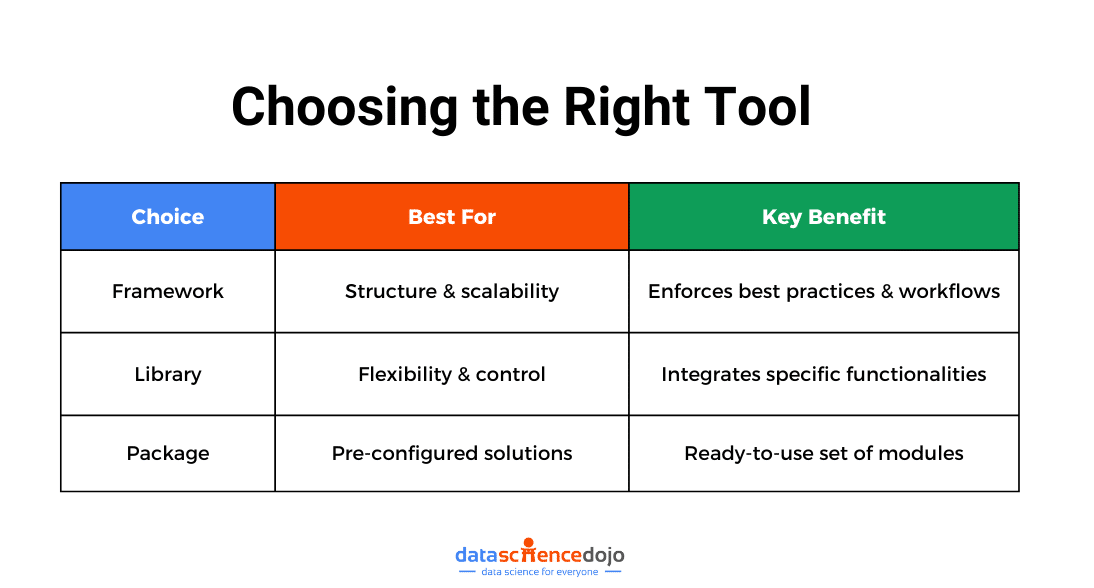When developing software, you rarely build everything from scratch. Instead, you rely on frameworks, libraries, and packages to streamline development, save time, and enhance functionality. But what exactly do these terms mean, and how do they differ?
Understanding these components is crucial for choosing the right tools for your projects. While frameworks provide a structured foundation, libraries offer reusable code for specific tasks, and packages bundle related modules together for easy installation and use.
In this blog, we’ll break down the key differences between frameworks, libraries, and packages, explore real-world examples, and help you decide which one best fits your development needs. Whether you’re a beginner or an experienced developer, mastering these concepts will boost your programming efficiency and help you build scalable, maintainable applications.
Understanding Frameworks, Libraries, and Packages

What Are Frameworks?
Frameworks are a set of classes, interfaces, and tools used to create software applications. They usually contain code that handles low-level programming and offers an easy-to-use framework for developers. Frameworks promote consistency by providing a structure in which to develop applications. This structure can also be used as a guide for customizing the activity of coding and adding features.
Examples of frameworks include .NET, React, Angular, and Ruby on Rails. The advantages of using frameworks include faster development times, easier maintenance, and a consistent structure across projects. However, frameworks can also be restrictive and may not be suitable for all projects.
What Are Libraries?
Libraries are collections of code that are pre-written and can be reused in different programming contexts. These libraries provide developers with efficient, reusable code, making it simpler and faster to create applications. Libraries are especially helpful for tasks that require complicated math, complicated graphics, and other computationally-intensive tasks.
Popular examples of libraries are jQuery, Apache ObjectReuse, .NET libraries, etc. The advantages of using libraries include faster development times, increased productivity, and the ability to solve common problems quickly. However, libraries can also be limiting and may not provide the flexibility needed for more complex projects.
What Are Packages?
Finally, packages are a collection of modules and associated files that form a unit or a group. These packages are useful for distributing and installing large applications and libraries. A package bundles the necessary files and components to execute a function, making it easier to install and manage them.
Popular examples of packages are Java EE, JavaServer Faces, Requests, Matplotlib, and Pygame. Pygame is a Python package used for building games. Java EE is a set of APIs for developing enterprise applications in Java. JavaServer Faces (JSF) is a UI framework for web apps in Java, and JavaFX is a package for building rich client apps in Java.
The advantages of using packages include increased functionality, faster development times, and the ability to solve specific problems quickly. However, packages can also be limiting and may not provide the flexibility needed for more complex projects.
Choosing the Right Tool for the Job
The main difference between frameworks, libraries, and packages is the level of abstraction they provide.
To put it simply…
-
Frameworks offer the highest level of abstraction because they establish the fundamental structure and rules that a developer must follow when building an application. They dictate how different components should interact, providing a solid foundation but also imposing certain constraints. Examples include Django for web development in Python and Angular for frontend JavaScript applications.
-
Libraries provide the least amount of abstraction, offering reusable code snippets for specific tasks without enforcing any project structure. Developers have full control over how and when to use them. For instance, Lodash simplifies JavaScript utility functions, while Pandas in Python aids in data manipulation.
-
Packages fall somewhere in between frameworks and libraries. They are collections of pre-written, modular components bundled together for easy installation and use. A package might contain one or more libraries and dependencies to perform a set of related tasks. For example, Requests in Python is a package that simplifies making HTTP requests, while Express.js is a lightweight web application package built on Node.js.
Understanding the Right Choice for Your Needs

Selecting the right tool depends on the requirements of your project:
-
If you need structure and scalability, a framework is ideal, as it enforces best practices and predefined workflows.
-
If you want flexibility and control, a library allows you to integrate specific functionalities as needed.
-
If you require a pre-configured solution for a particular task, a package provides a ready-to-use set of modules.
For those exploring Node.js libraries, you can find a comprehensive list of options here to help streamline development and enhance functionality.
By understanding the differences and choosing the right tool, developers can optimize efficiency, maintainability, and scalability in their projects.
Integration Techniques: Managing Multiple Libraries and Packages
When working on a software project, integrating multiple libraries and packages is essential for adding functionality without reinventing the wheel. However, managing dependencies efficiently can prevent conflicts and ensure smooth project execution. Below are key techniques to integrate libraries and packages effectively:
1. Use a Dependency Manager
Most programming languages offer dependency managers that help install, update, and manage packages:
-
Python: Use
piporcondato install and maintain packages. -
JavaScript: Use
npmoryarnfor seamless package management. -
Java: Use
MavenorGradlefor handling dependencies.
By defining dependencies in a requirements file (e.g., requirements.txt for Python or package.json for JavaScript), you can ensure consistency across environments.
2. Handle Dependency Conflicts
Dependency conflicts occur when two libraries require different versions of the same package. To resolve this:
-
Check for compatibility: Review the official documentation of the libraries you are integrating.
-
Use virtual environments: Tools like
venv(Python) ornvm(Node.js) allow you to isolate dependencies per project. -
Update dependencies cautiously: Use
pip checkornpm auditto detect and resolve conflicts before updating.
3. Follow Semantic Versioning
Packages often follow semantic versioning (MAJOR.MINOR.PATCH). Always:
-
Prefer stable versions over beta releases.
-
Lock package versions (
pip freeze > requirements.txt) to prevent unintended updates. -
Regularly audit dependencies to remove outdated or unsupported ones.
4. Test Compatibility
Before integrating a new library:
-
Create a test environment and check for issues before deployment.
-
Use continuous integration (CI) tools like GitHub Actions or Jenkins to automate dependency checks.
-
Run tests after updating packages to ensure nothing breaks.
5. Monitor Security Risks
Using third-party libraries introduces security risks. To mitigate them:
-
Regularly scan dependencies with tools like
npm auditorpip-audit. -
Check for official security patches and apply updates promptly.
-
Avoid unmaintained libraries with outdated dependencies.
Latest Developments in Frameworks and Libraries
The rapid advancement of technology has led to the continuous evolution of frameworks and libraries, especially in fields like machine learning (ML) and artificial intelligence (AI). Developers now have access to powerful tools that simplify complex tasks, enhance performance, and improve scalability. Below are some of the latest and most impactful frameworks and libraries shaping the future of software development.
1. AI and Machine Learning Frameworks
New AI-focused frameworks make it easier to build, train, and deploy models efficiently:
-
PyTorch 2.0 – A significant update to the popular deep learning library, featuring faster computation and dynamic graph execution for improved model training.
-
TensorFlow 2.x – Enhanced support for Keras, streamlined APIs, and better deployment capabilities for edge AI applications.
-
JAX – A high-performance ML library from Google, designed for just-in-time (JIT) compilation and automatic differentiation.
2. Low-Code and No-Code AI Development
For those without extensive programming experience, low-code/no-code AI tools provide an accessible way to build models:
-
Hugging Face AutoTrain – Automates the training of NLP models with minimal coding.
-
Google Vertex AI – A unified AI platform that enables developers to train and deploy models without deep ML expertise.
-
MLflow – Helps track ML experiments, manage models, and streamline the MLOps lifecycle.
3. Web Development & Cloud-Based Libraries
Developers are increasingly leveraging cloud-based libraries to optimize web applications:
-
Next.js 14 – The latest version of this React framework brings better performance, improved caching, and native support for server components.
-
Bun – A new JavaScript runtime that competes with Node.js by offering faster execution speeds and built-in package management.
-
Cloudflare Workers AI – A serverless AI execution environment allowing developers to deploy AI models closer to users for real-time processing.
4. Data Science and Big Data Processing
New libraries enhance large-scale data processing and analytics:
-
Polars – A high-performance DataFrame library in Rust that outperforms Pandas for large-scale data manipulation.
-
DuckDB – A fast in-memory SQL analytics engine designed for complex queries on structured data.
-
Apache Iceberg – A next-generation table format for big data analytics, improving performance and versioning in data lakes.
5. Security-Focused Libraries
With rising cybersecurity concerns, new security-oriented libraries help developers build safer applications:
-
OWASP Dependency-Check – Identifies known vulnerabilities in project dependencies.
-
Sigstore – A tool for cryptographically signing and verifying software artifacts to enhance software supply chain security.
-
Pyre – A static type checker for Python that detects potential security risks in codebases.
Final Thoughts
Choosing between frameworks, libraries, and packages comes down to understanding their level of abstraction and how they fit your development needs. Frameworks provide structure, libraries offer flexibility, and packages simplify dependency management. By selecting the right tool for the job, you can optimize efficiency, improve scalability, and build maintainable applications.
As technology evolves, new tools and updates continue to shape the development landscape. Staying informed about the latest frameworks and libraries will help you adapt to industry trends and enhance your programming skills. Whether you’re working on a small project or a large-scale application, leveraging these tools effectively can make all the difference in your software development journey.
Written by Dagmawit Tenaye





